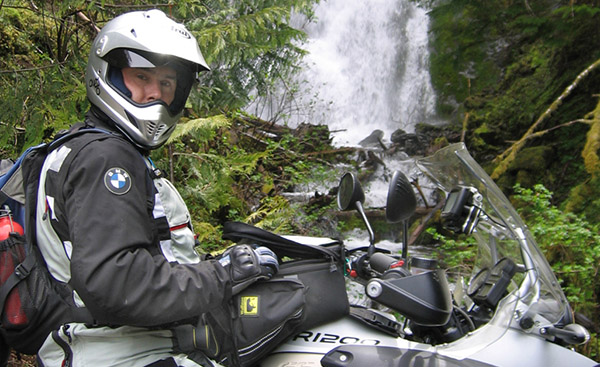 United States – Part 2: Balancing and Steering
United States – Part 2: Balancing and Steering
I started this series with the idea that a “good rider” is more than someone who can go fast on the track, and I suggested a list of characteristics that I think would define my ideal “good rider.”
My list started with: A good rider is a motorcyclist who is skillful in control of a wide variety of motorcycles.
Of course, different machines balance, accelerate, corner, and stop differently.
I hope you haven’t developed a bigotry that prevents you from appreciating motorcycles that have more than two wheels. We’ll get to trikes and sidecar rigs later.
First, let’s review some basic control techniques that are common to all two-wheeled motorcycles. I will generally refer to two-wheeled motorcycles as “bikes.”
For a novice (a new rider) balancing a bike is a bit tricky. It isn’t intuitive what you need to do with the grips. The machine may suddenly decide to head off in some direction you hadn’t intended, and it’s not clear what you need to do to get it pointed where you want it to go.
Perhaps you can’t make a right turn without crossing the centerline, or can’t ride up to a stop sign without dragging your feet on the ground to hold the bike upright.
For some, even after a lifetime of riding, balancing and steering is a continuous struggle. For most riders, something clicks after a few months, and balance suddenly becomes easier.
Let’s think through why bikes do what they do, and suggest some techniques for becoming boss of the bike rather than letting the bike boss you around. First, how does a bike balance? What forces hold it up? And what forces do we use to steer a bike into a turn?
Balancing
Let’s imagine three different ways a bike balances in relation to the tire contact patches. Think of a bike in motion, as viewed from the front.
 If there were a strong gust of wind, the tire contact patches might continue in a straight line, but the top of the bike would be blown downwind (Roll A).
If there were a strong gust of wind, the tire contact patches might continue in a straight line, but the top of the bike would be blown downwind (Roll A).
The flip side of that would be if something forced the tire contact patches away from center, perhaps a groove in the road, or pavement that’s not level.
The rider’s head would continue straight ahead, but the wheels and rest of the bike would roll sideways (Roll B).
Another possible way the bike could roll is that the mass of the machine and rider continue straight ahead, but the contact patches move one way, and the top of the bike rolls in the opposite direction (Roll C).
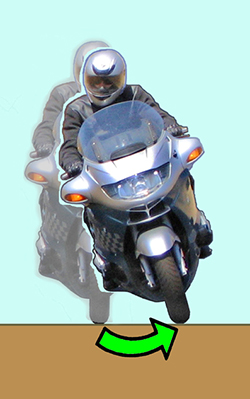 You might wonder why it makes any difference how a bike rolls to one side or the other.
You might wonder why it makes any difference how a bike rolls to one side or the other.
Well, there are some situations where you absolutely need to understand what’s happening.
A novice rider can get away with lack of skill most of the time, but when a strange situation develops you need proficient skills.
Let’s note that the rider doesn’t have much control over Roll A.
Other than a crosswind blast, the rider doesn’t have anything to push against to cause the top of the bike to move.
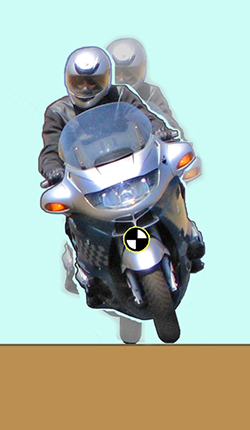 A heavy motorcycle will be reluctant to roll as in Roll B because the bike’s mass wants to continue moving straight ahead, not sideways.
A heavy motorcycle will be reluctant to roll as in Roll B because the bike’s mass wants to continue moving straight ahead, not sideways.
The most typical way a motorcycle rolls is Roll C, with the “hinge point” being the Center of Mass, which is represented by the little round symbol.
A bike actually balances itself in a more-or-less straight line, but let’s consider what a rider can do to control balance.
Let’s say the bike becomes unbalanced and starts to lean over toward the left.
You might wonder why it makes any difference how a bike rolls to one side or the other. Well, there are some situations where you absolutely need to understand what’s happening.
 A novice rider can get away with lack of skill most of the time, but when a strange situation develops you need proficient skills.
A novice rider can get away with lack of skill most of the time, but when a strange situation develops you need proficient skills.
Let’s note that the rider doesn’t have much control over Roll A. Other than a crosswind blast, the rider doesn’t have anything to push against to cause the top of the bike to move.
A heavy motorcycle will be reluctant to roll as in Roll B because the bike’s mass wants to continue moving straight ahead, not sideways.
The most typical way a motorcycle rolls is Roll C, with the “hinge point” being the Center of Mass, which is represented by the little round symbol.
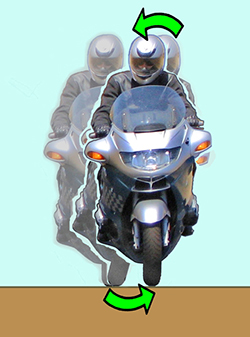 A bike actually balances itself in a more-or-less straight line, but let’s consider what a rider can do to control balance.
A bike actually balances itself in a more-or-less straight line, but let’s consider what a rider can do to control balance.
Let’s say the bike becomes unbalanced and starts to lean over toward the left.
The rider can momentarily steer the front wheel slightly toward the left until the bike is rebalanced. Note that the bike will be in a slightly different position on the road.
Actually, the rider doesn’t have to constantly steer to maintain balance. The geometry of the front end contributes to self-balancing. Tire drag off-center (and other forces) steers the front wheel toward the direction of lean, rebalancing the bike. Even when you believe the bike is rolling ahead in a “straight line”, the front wheel makes a very slight weave from side to side as the bike balances itself.
Let’s note that a bike doesn’t always roll exactly around its Center of Mass. The bike is carving an arc through space, and the actual geometric center of the roll/curve can be far away from the motorcycle, even below ground level, and move around to entirely different locations during the corner.
But you might find it useful to imagine a bike rolling around an imaginary CoM that’s approximately centered between the rider’s knees. Whether the bike is self-balancing, or the rider is controlling balance, the dominant force is a result of the position of the front wheel contact patch.
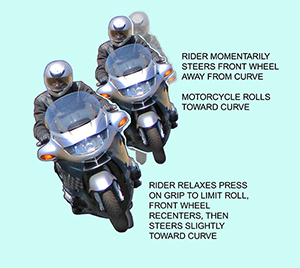
The spinning wheels and engine also generate gyroscopic stability that helps hold the bike vertical and pointed generally in a straight-ahead direction. That’s why it is possible for a bike to motor down the road with the rider’s hands off the grips, at least for a well-balanced machine and load.
Whether or not that’s a smart tactic is a separate issue. And, of course, machines that are heavier on one side than the other will not balance in a straight line.
Steering
To get a bike to turn, it must first be leaned. And leaning is just the opposite of balancing. To get the bike to lean toward a turn, the rider momentarily steers the front wheel opposite the intended lean. In other words, to lean right, the rider momentarily steers slightly toward the left.
The wheel tracks away from center, forcing the top of the bike to roll toward the right. As the bike rolls over to an angle appropriate to the turn, the rider eases up on the grips, allowing the front wheel to return to center, and then to point slightly toward the curve. Once leaned over and turning, the axle of the front wheel points approximately to the center of the turn circle.
The front wheel doesn’t have to steer very far to cause the bike to roll. The movement is so slight you might suspect that the bike rolls toward the turn without the front end steering at all, but in fact the front wheel does steer away from center a tiny amount, perhaps 0.5 to 0.8 degrees at highway speed. Just a slight nudge on the grips results in the front wheel out-tracking quickly and with considerable force. The more aggressively you attempt to roll the bike toward a curve, the more obvious will be the steering of the front wheel.
Wheels as Gyroscopes
More than a few riders have theorized that the gyroscopic action (precession) of the front wheel is what causes the roll toward the curve. After all, if you hold a spinning bicycle wheel by its axles and “steer” it toward the left, it leans right. But let’s note that this experiment is with the wheel in the air, not in contact with the ground like a motorcycle front tire. What’s more, precession is a function of wheel/tire mass, rotational speed, and steering deflection. A deflection of less than a degree won’t produce much precessive force at speeds under 200 mph.
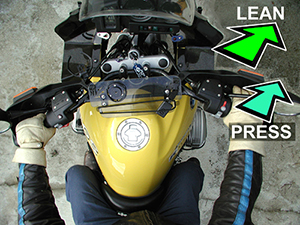
Let’s also note that the front wheel is steered back across center once the bike has rolled to an acceptable lean angle. If gyroscopic precession were the dominant force causing the bike to roll, then steering the front wheel toward the curve would just roll the bike back to vertical.
Actually, the gyroscopic stability of the wheels is very important, because it resists roll. Gyroscopic stability allows the rider to make predictable steering inputs that aren’t so quick or forceful the bike is uncontrollable. Think of the gyroscopic behavior of the wheels as a centering spring the rider must overcome to make steering inputs.
One reason for understanding all this, is that raised edges or grooves that trap the front tire can wrestle balance out of your grasp. Imagine easing your bike up parallel to a raised curb on your right. As the front tire snuggles up to the curb, you won’t be able to steer the front end left-right. And without steering control, you will find it difficult, perhaps impossible, to keep the bike balanced. The lesson in this is that it’s steering the contact patch that controls balance and direction.
For a little homework, take your bike for a spin. Find some vacant road or empty parking lot for an experiment. Get the bike up to say 35 mph, and nudge the left grip—making a point to not resist the nudge with your other hand. You’ll notice the bike leans and steers more toward the left.
Press on the right grip, and the bike will move right. Experiment with this enough to convince yourself that steering the front wheel is the dominant force that controls balance and direction for a bike.
If you’re astute, you may notice that the front tire out-tracks just before the bike rolls and turns. That’s more obvious when you’re cornering. And, although you know the actual movement of the handlebar grip is forward, the result of countersteering is the bike rolling into a lean. It’s acceptable to imagine that you press down on the grip to cause the bike to lean. Your subconscious will take care of the minor details.
David Hough
Based on a series created for publication on a USA web site – Part 2: Balancing and Steering


Leave a Reply